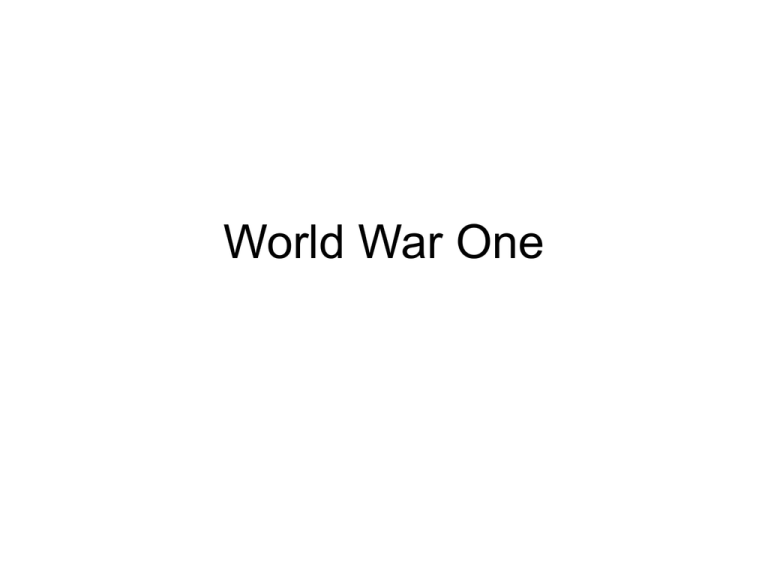World War One
advertisement

World War One Situation on the Eve of hostilities • British being starved by German U-Boats • Feared they would be out of war by Oct 1917. American Navy • American navy was in a position to help Allies • Admiral William Sims convinced British to try new system—Convoy system – Destroyers and other small anti-submarine vessels escorted merchant ships across the Atlantic • Not a perfect system but reduced the crisis • Second ½ of 1917—great reduction in ship losses. • The US also embarked on a massive shipbuilding program. – Build ships faster than Germans could sink them. Army • Less prepared to make an immediate contribution. • Force of 210,000 men with 97,000 National Guardsmen in federal service. • Little or no equipment. • Want to make symbolic gesture of support to Allies-send a Division over immediately – Scrap together forces to create-1st Infantry Division – Would take months in Europe to prepare them for combat John Pershing • Wilson selects Pershing to lead American forces in Europe – Combat experience in Mexico – Controversial choice • Junior to 5 other officers • Sent immediately to Europe to assess the situation and set up headquarters. How big a force? • Initial estimates 1 million man force – 1 full field army—20 divisions strong with support personal • Pershing would consistently increase these figures until they reached 100 divisions strong. • A force of this size over 3 million men would have greatly taxed the American economy. • Eventually 62 divisions would be formed with 43 going overseas. American Divisions • American army had oversized divisionsalmost 28,000 men – Double the size of Allied or German divisions – Pershing wanted a forced large enough to have striking AND staying power on the attack. – Ability to overwhelm enemy Mobilization of Industry • To meet the needs of forces, military needed to coordinate activities with civilian industry • Massive contracts to supply all needs of modern military force operating overseas. • American industry unable to meet many of the needs in a prompt way • Army forced to use materials supplied by Allies • Not until the end of the war did American industry start to meet quotas. Officers Corps • Military decided to go in a new direction – In past officers selected based on status and political connections • Test all inductees for mental aptitude – Culturally biased – Drew conclusion that most troops were idiots • Officer Training Schools Americans in Combat • 1st Division put into action in October 1917 • Did a rotation with French units before committed to a “Quiet Section” of the front Pressure from Allies • Quickly realized that it would take a long time before American forces would be ready to assume unit role. • Wanted Americans fed into British and French units as replacements. – Believed request was logical – Possessed leadership, artillery, tanks and aviation but lacked manpower • Americans insisted on a separate force German Offensive • Germans moved large numbers of troops from Russian front to Europe. • Launch 5 major massive offensives against British forces – Advanced over 40 miles – Take 70,000 prisoners, 200,000 casualties • Bogs down – Loot British trenches for food—slows advance – Fails to destroy British Army, loss of elite troops American forces grow • By July 4, 1918, one million American have arrived in France • 250,000 troops arriving in Europe each month. • Begin to tip the scale • Ready to launch offensive. St. Mihiel • September 1918 • 1st major offensive--good test – Europeans had doubts—inexperienced officers • American able to seize territories quickly with few casualties • Important for morale – Could run an independent operation – Staff planning, skilled officers, good troops Air War • War creates major building program – Produces 1,200 aircraft – Most use French-made planes • William Mitchell—Head of Air Corps • 94th Squadron-1st unit in action – Eddie Rickenbacher—26 kills – Used in Meuse-Argonne offensive • Ground support • Bombing raids • Mitchell envisioned a very different future




